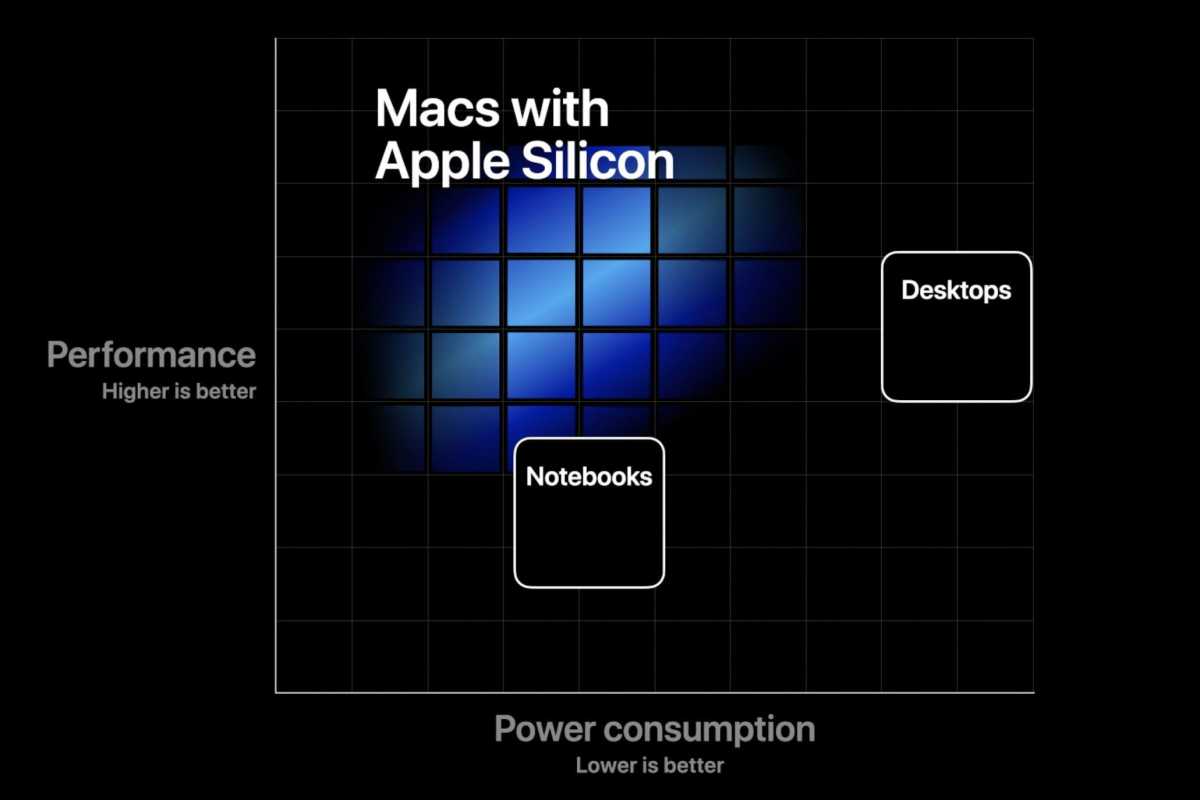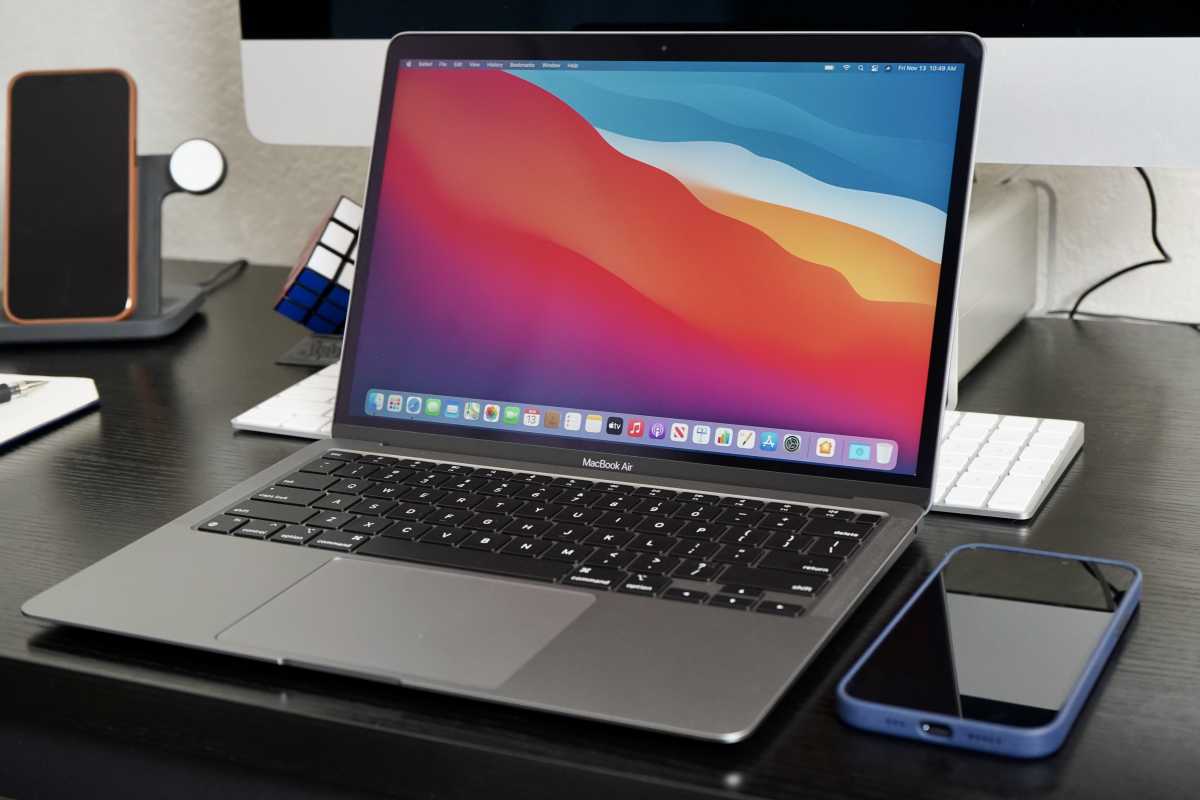The launch of the Mac Studio was a big moment for Apple. After years of preparation, that launch marked an important milestone in the Mac’s journey. Apple exec John Ternus’s declaration that the M1 chip family is complete marks the end of the first Apple silicon product cycle.
But the wheel keeps turning. The first cycle answered numerous questions we were wondering about less than two years ago–but many more questions remain. To paraphrase Winston Churchill, this is only the end of the beginning.
Mysteries revealed
Before the Apple silicon transition was announced in June 2020, there were so many questions about how it might work. Many of us had concerns that Apple’s processors, designed for the iPhone and then beefed up for the iPad, would not be able to handle the needs of Mac users, or at least pro-level Mac users.
In early 2020, my podcasting partner Myke Hurley predicted that Apple would transition its consumer Macs to Apple-built processors by now but couldn’t quite bring himself to predict the same for pro Macs. And yet here we sit, with Apple having rolled out the M1 Pro, M1 Max, and M1 Ultra chips–to the applause and delight of Mac fans everywhere. Only the Mac Pro lurks off in the distance, yet to be assimilated.
 https://b2c-contenthub.com/wp-content/uploads/2022/01/mac-apple-chart.jpeg?resize=300%2C200&quality=50&strip=all 300w, https://b2c-contenthub.com/wp-content/uploads/2022/01/mac-apple-chart.jpeg?resize=768%2C512&quality=50&strip=all 768w, https://b2c-contenthub.com/wp-content/uploads/2022/01/mac-apple-chart.jpeg?resize=1200%2C800&quality=50&strip=all 1200w, https://b2c-contenthub.com/wp-content/uploads/2022/01/mac-apple-chart.jpeg?resize=1536%2C1024&quality=50&strip=all 1536w, https://b2c-contenthub.com/wp-content/uploads/2022/01/mac-apple-chart.jpeg?resize=2048%2C1365&quality=50&strip=all 2048w, https://b2c-contenthub.com/wp-content/uploads/2022/01/mac-apple-chart.jpeg?resize=1240%2C826&quality=50&strip=all 1240w, https://b2c-contenthub.com/wp-content/uploads/2022/01/mac-apple-chart.jpeg?resize=150%2C100&quality=50&strip=all 150w" width="1200" height="800" sizes="(max-width: 1200px) 100vw, 1200px" />
https://b2c-contenthub.com/wp-content/uploads/2022/01/mac-apple-chart.jpeg?resize=300%2C200&quality=50&strip=all 300w, https://b2c-contenthub.com/wp-content/uploads/2022/01/mac-apple-chart.jpeg?resize=768%2C512&quality=50&strip=all 768w, https://b2c-contenthub.com/wp-content/uploads/2022/01/mac-apple-chart.jpeg?resize=1200%2C800&quality=50&strip=all 1200w, https://b2c-contenthub.com/wp-content/uploads/2022/01/mac-apple-chart.jpeg?resize=1536%2C1024&quality=50&strip=all 1536w, https://b2c-contenthub.com/wp-content/uploads/2022/01/mac-apple-chart.jpeg?resize=2048%2C1365&quality=50&strip=all 2048w, https://b2c-contenthub.com/wp-content/uploads/2022/01/mac-apple-chart.jpeg?resize=1240%2C826&quality=50&strip=all 1240w, https://b2c-contenthub.com/wp-content/uploads/2022/01/mac-apple-chart.jpeg?resize=150%2C100&quality=50&strip=all 150w" width="1200" height="800" sizes="(max-width: 1200px) 100vw, 1200px" />Apple
This, to me, is the most breathtaking aspect of this first cycle of Apple silicon on the Mac: All those concerns about Apple’s ability to get professional-level Mac performance out of its chip architecture have vanished. When the M1 Macs arrived in the fall of 2020, they were so impressive that doubt about higher-end chips began to melt away. The arrival of the MacBook Pro in the fall of 2021 just clinched the deal. The M1 era has exceeded all expectations.
So what’s next?
Waiting in the wings
While we have a much better idea of Apple’s Mac processor strategy now than we did two years ago, it’s very hard to predict trends from a single data point. We can assume a lot of the M2 generation will look similar to the M1… but there will also be differences.
Apple will undoubtedly be looking to push performance and functionality forward, both at the high end and the low end. And the mystery of the Apple silicon Mac Pro adds a wrinkle.
The M1 blew us all away with its balance of speed and efficiency. An M2 won’t be able to take advantage of the enormous improvements made by simply stepping from Intel to Apple processors–but if the improvements between Apple’s A14 and A15 processors are any indication, a 10 to 15 percent improvement in per-core speed wouldn’t be a surprise.
What Apple won’t be doing in the M2, at least according to Bloomberg’s Mark Gurman, is boosting the number of processing cores the base-model chip offers. How quickly we become jaded to the lowest-powered Mac models sporting 8-core CPUs! (The first Mac laptop with eight CPU cores was launched three years ago. Now they’ve all got them.)
Gurman’s report suggests that Apple will boost the maximum number of GPU cores in the M2 to 10, providing a more substantial graphics boost. For me, the big question is not about the speed of the M2. It’s about how well that new chip addresses the limitations of the M1. Macs with base-model M1 processors were limited to 16GB of RAM and two Thunderbolt ports. Those M1 Macs also had limited support for external displays–a single external display works fine, but things get dicey after that.
As we climb the ladder, the M2 Pro and Max chips introduced with the MacBook Pro will likely get beefier than their M1 Pro and M1 Max counterparts. Gurman’s report suggests Apple will add two CPU cores, to max out at 12, while GPU cores will remain where they are. The M2 Ultra, being made out of two M2 Max chips, will gain four cores, for a total of 24.
 https://b2c-contenthub.com/wp-content/uploads/2021/09/A15-CPU.jpg?resize=300%2C200&quality=50&strip=all 300w, https://b2c-contenthub.com/wp-content/uploads/2021/09/A15-CPU.jpg?resize=768%2C512&quality=50&strip=all 768w, https://b2c-contenthub.com/wp-content/uploads/2021/09/A15-CPU.jpg?resize=1200%2C800&quality=50&strip=all 1200w, https://b2c-contenthub.com/wp-content/uploads/2021/09/A15-CPU.jpg?resize=1240%2C826&quality=50&strip=all 1240w, https://b2c-contenthub.com/wp-content/uploads/2021/09/A15-CPU.jpg?resize=150%2C100&quality=50&strip=all 150w" width="1200" height="800" sizes="(max-width: 1200px) 100vw, 1200px" />
https://b2c-contenthub.com/wp-content/uploads/2021/09/A15-CPU.jpg?resize=300%2C200&quality=50&strip=all 300w, https://b2c-contenthub.com/wp-content/uploads/2021/09/A15-CPU.jpg?resize=768%2C512&quality=50&strip=all 768w, https://b2c-contenthub.com/wp-content/uploads/2021/09/A15-CPU.jpg?resize=1200%2C800&quality=50&strip=all 1200w, https://b2c-contenthub.com/wp-content/uploads/2021/09/A15-CPU.jpg?resize=1240%2C826&quality=50&strip=all 1240w, https://b2c-contenthub.com/wp-content/uploads/2021/09/A15-CPU.jpg?resize=150%2C100&quality=50&strip=all 150w" width="1200" height="800" sizes="(max-width: 1200px) 100vw, 1200px" />Apple’s performance history with its A-series chips for iPhone can provide an idea of how much of a performance increase we could see between M-series generations.
Apple
That leaves us with the mystery of the Mac Pro. Gurman’s report suggests that Apple will offer a new variety of chip that melds four M2 Max chips into an “M2 Extreme”, and you can do the math on that–it would have up to 48 CPU cores and 128 GPU cores.
That’s the easy part. The mystery is how an Apple silicon Mac can be internally expandable. Part of Apple silicon’s secret sauce is integrating both graphics and memory into the processor package, making it one big soup of processors and memory. There have been some suggestions that Apple might allow extreme amounts of RAM on a future Mac Pro by treating on-chip memory as a high-speed cache, supporting enormous amounts of RAM on more conventional (but slower) memory slots. And that maybe Apple would offer expansion cards of its own with even more Apple-designed GPU cores.
Which, sure, any of that could be true. But here’s what you really need to know: The existing Mac Studio performance is so strong, especially with the M1 Ultra version, that the Mac Pro really only needs to serve the smallest slice of Mac users out there. Those users are important, and their needs are truly extreme. I imagine that Apple has spent a lot of time talking to many of those users and figuring out how its Apple silicon model can be modified to give them what they need.
What we’ll probably see in that Mac Pro are some unusual approaches that will be very expensive… but will be designed to serve users who are more concerned with performance than price. That’s been true of the very high end of computing for a long time, and it’s still true. The current Mac Pro starts at $6,000, and it wouldn’t surprise me if a new model started at a similar price–consider it a Mac Studio with a couple thousand added on for a more expansive design. But the important Mac Pro customers won’t be buying that base model. They’ll be loading it up with whatever high-end features Apple has made for them–and they’ll pay mind-melting prices for the privilege.
For the rest of us run-of-the-mill power users, there will always be the Mac Studio. And maybe even a pro-level iMac! We’ll see.
What we don’t know
There are still a lot of factors in the march of Apple silicon that we won’t be able to know until the M2 cycle completes, if not longer. Chief among them is Apple’s plan for the pace of Mac updates. During the Intel era, Apple couldn’t really decide on its own when it wanted to update Mac models because it depended–at least in part–on when Intel could provide it with the chips it wanted to use on particular models.
Now Apple gets to chart its course–and has nobody to blame but itself for any delays. According to Bloomberg’s Gurman, every Mac model will be updated with M2 processors by the end of 2023. Given that the first M2 Macs are likely to come out in mid-2022, that strongly suggests Apple is considering an 18-month upgrade cycle. That’s not bad, especially given the sluggish upgrade cycles during much of the Intel era.
 https://b2c-contenthub.com/wp-content/uploads/2021/03/macbook-air-m1.jpg?resize=300%2C200&quality=50&strip=all 300w, https://b2c-contenthub.com/wp-content/uploads/2021/03/macbook-air-m1.jpg?resize=768%2C512&quality=50&strip=all 768w, https://b2c-contenthub.com/wp-content/uploads/2021/03/macbook-air-m1.jpg?resize=1200%2C800&quality=50&strip=all 1200w, https://b2c-contenthub.com/wp-content/uploads/2021/03/macbook-air-m1.jpg?resize=1536%2C1024&quality=50&strip=all 1536w, https://b2c-contenthub.com/wp-content/uploads/2021/03/macbook-air-m1.jpg?resize=2048%2C1365&quality=50&strip=all 2048w, https://b2c-contenthub.com/wp-content/uploads/2021/03/macbook-air-m1.jpg?resize=1240%2C826&quality=50&strip=all 1240w, https://b2c-contenthub.com/wp-content/uploads/2021/03/macbook-air-m1.jpg?resize=150%2C100&quality=50&strip=all 150w" width="1200" height="800" sizes="(max-width: 1200px) 100vw, 1200px" />
https://b2c-contenthub.com/wp-content/uploads/2021/03/macbook-air-m1.jpg?resize=300%2C200&quality=50&strip=all 300w, https://b2c-contenthub.com/wp-content/uploads/2021/03/macbook-air-m1.jpg?resize=768%2C512&quality=50&strip=all 768w, https://b2c-contenthub.com/wp-content/uploads/2021/03/macbook-air-m1.jpg?resize=1200%2C800&quality=50&strip=all 1200w, https://b2c-contenthub.com/wp-content/uploads/2021/03/macbook-air-m1.jpg?resize=1536%2C1024&quality=50&strip=all 1536w, https://b2c-contenthub.com/wp-content/uploads/2021/03/macbook-air-m1.jpg?resize=2048%2C1365&quality=50&strip=all 2048w, https://b2c-contenthub.com/wp-content/uploads/2021/03/macbook-air-m1.jpg?resize=1240%2C826&quality=50&strip=all 1240w, https://b2c-contenthub.com/wp-content/uploads/2021/03/macbook-air-m1.jpg?resize=150%2C100&quality=50&strip=all 150w" width="1200" height="800" sizes="(max-width: 1200px) 100vw, 1200px" />If Apple decides to put its Macs on an 18-month update cycle, we could see new M1-based Macs like the MacBook Air upgraded to the M2 this year.
Jason Cross/IDG
While using an 18-month cycle doesn’t seem unreasonable, it brings up another mystery: What philosophy will Apple be following regarding how the M series of processors relate to the A series it uses in iPhones? Apple’s A-series chip cycle matches its iPhone releases; there’s a new A-series chip every 12 months. The M2 chips are likely based on the A15 processor introduced in the iPhone last fall.
What does that relationship look like over time? Do Mac processors always trail an iPhone processor, skipping the occasional generation to catch up? Does the iPhone remain the base from which all other Apple processors emerge, or will the M-series become so unrecognizable that it will be impossible to say whether the inevitable M3 is based on the A16 or A17?
We don’t know and won’t know for a while yet. But now that we stand with one turn of the wheel completed, we’re starting to see the outline of Apple’s vision for the future of the Mac. Now pause, take a deep breath, and compose yourself. This is a brief respite. In a few months, the wheel begins to turn again with the arrival of the first M2 Macs. I can’t wait to see what they deliver.





